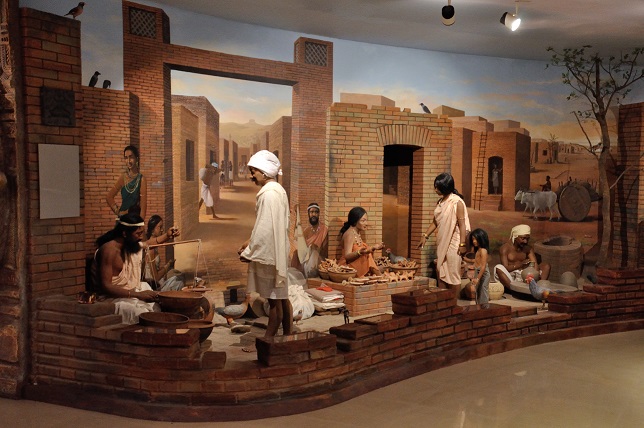The Indus Valley Civilization or Harappan Civilization was one of the oldest civilizations on earth. Archaeologists have different opinions on this timeline, but the most appropriate period for Indus Valley Civilization is 2500BC to 1750BC. The Mesopotamian Civilization, Egyptian Civilization, and Hang Ho Civilization are other important civilizations contemporary to the Indus Valley Civilization.
Since Harappa was the first site discovered in the Indus valley civilization, it is commonly referred to as the Harappan Civilization in archaeological surveys. Most of the Indus valley civilization sites were founded on the banks of the Saraswati river, so the Indus valley civilization is also referred to as the Indus-Saraswathi civilization. In Rigvetas, Saraswati is referred to as the most pious river.
We can divide the entire history into 3 parts:
- Pre-history: written records are not available.
- Proto-history: records are available but not decipherable.
- History: written records are available.
Indus valley civilization falls under the Proto-History period, which happened around 2500BC – 1750BC.
The Archeological Survey of India (ASI)
The Archeological Survey of India, or ASI, was founded in 1861. Alexander Cunningham was the first director-general of ASI. When the Harappan Civilization was discovered, John Marshall was the director-general of ASI, and he was the first person to use the term “Indus Civilization”. The Indus Valley civilization was spread over Sindh, Baluchistan, Punjab, Haryana, Rajasthan, Gujarat, and some parts of Uttar Pradesh and Maharashtra.
- Northern most site: Ropar (bank of Sutlej river in Punjab)
- Southern most site: Bhagatrav (bank of Kim river in Gujarat)
- Eastern most site: Alamgirpur (bank of Hindon river in U.P.)
- Western most site: Sutkagendor (bank of Dashk river in Pakistan-Iran border)
Harappa and Mohenjodaro were the capital cities. Lothal, Sutkagendor, Allahdino, Balakot, and Kuntasi were the port cities.
Important sites, their locations and findings
| Site (River) | Location | Findings | Important Excavators |
| Harappa (Ravi) | Punjab, Pakistan | 6 Granaries, Cemetery, Stone symbol of Lingam & Yoni, Painted pottery, Clay figures. | Daya Ram Sahni (1921) |
| Mohenjo-Daro (Indus) | Sindh, Pakistan | Great Granary, Great Bath, Assembly hall, Mesopotamian seals and dice. | Rakhal Das Bannerji (1922) |
| Chanhudaro (Indus) | Sindh, Pakistan | City without citadel, Inkpot, lipstick, Metal works and terracotta models. | Mackay (1925) & N.G. Mazumdar (1931) |
| Lothal (Bhogava) | Gujarat, India | Dockyard, Rice husk, Metal works, shell ornaments, terracotta model of ship. | S. R. Rao (1954) |
| Dholavira (Luni) | Gujarat, India | Water reservoirs and water harnessing system. | J. P. Joshi (1967) |
| Kalibanga (Ghaggar) | Rajasthan, India | Ploughed field, 7 fire alters and Mesopotamian cylindrical seals. | Amalanand Gosh (1951) |
| Banawali (Ghaggar) | Haryana, India | Lack of town planning and drainage system. | R. S. Bist (1973) |
Mohenjodaro (Sindh, Pakistan) – Largest site of Indus Civilization
Rakhigarhi (HR) – Largest Indian site of Indus Civilization
Sinauli (U.P.) – Recently discovered site, ASI believes Sinauli is contemporary to Harappan Civilization.
The Features of IVC Cities.
- Indus Civilization was mainly urban type.
- Systematic town planning in grid format.
- Proper drainage system through the streets.
- Use of burned bricks to construct buildings.
- Fortified citadel, except for Chanhu-daro.
Major Crops Cultivated
- Wheat and barley were commonly cultivated.
- Dates and mustard were also cultivated.
- The Harappans were the first to produce cotton.
Trade and Economy
- The barter system was commonly used for the trade of goods.
- It is believed that a robust foreign trade relationship was active during this period. The Mesopotamian seals found in Mohenjo-daro were evidence for that.
- Lothal was a port city to support the trade. Terracotta models of ships were found here.
- ‘Steatite‘ is mainly used to manufacture seals. Humpless bull can also be seen in most of the Indus Valley seals.
Worship and Culture
- Harappans didn’t worship their gods in temples. No evidence of temples has been found yet.
- Matridevi, or Mother Goddess, was the most commonly found god figure.
- Iron was not known to the Indus people.
- The Lion was also unknown to the people of the Indus Valley.
Literature
The Harappan script is the oldest script in the Indian subcontinent, but it has not been deciphered yet. Pictographic script is mainly used. Evidence from Kalibanga shows that they used to write from right to left and from left to right in alternative lines.
The origin of the ‘Swastika’ symbol is believed to be from the Indus Valley Civilization.
Decline of Indus Valley Civilization
According to M. Wheeler, “Indra” is accused of being the reason behind the decline of the Indus Valley Civilization.
Rigveda mentions that the battle held at ‘Hariyumpia’ is the reason behind the decline. Later, ‘Hariyumpia’ is identified as ‘Harappa’.
